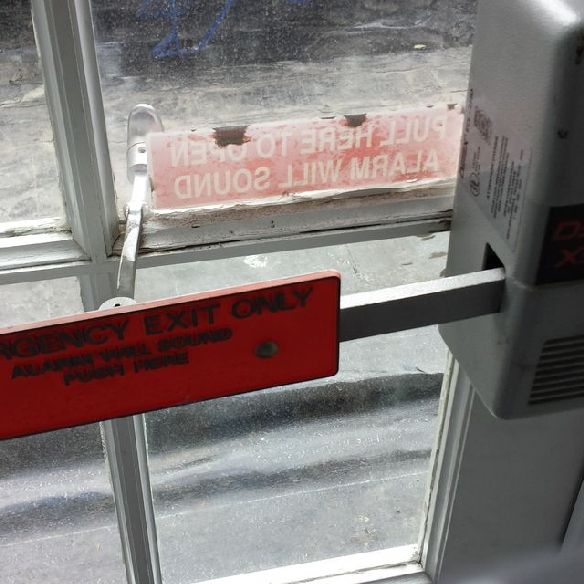This photo may be one of my favorite Fixed-it Friday photos ever. It was sent to me by Michael Carney of Allegion. The pictured application is in place on the roof door and all of the fire escape access doors in a dormitory high-rise. A very creative way to install an exit alarm, but I don’t know how secure or how durable it is.
The mention of fire escapes reminded me of a question that was asked recently (unrelated to the photo above). I don’t do much with fire escapes, but there are plenty of them on existing buildings, and the question was this:
If the access window/door leading to a fire escape is within a room, can the door from the corridor to the room be lockable?
In the building that inspired the question, the fire escape access window was in the boss’ office, and the boss wanted to lock his office door. If the fire escape was only serving the room in question the answer might be different, but this fire escape served as the second means of egress for the entire floor of the building. It seems logical that the office door would have to be unlocked at all times, but I went looking for evidence of that.
I found this in the 2015 edition of the International Fire Code (IFC):
1104.16.4 Access. Access to a fire escape stairway from a corridor shall not be through an intervening room. Access to a fire escape stairway shall be from a door or window meeting the criteria of Section 1005.1. Access to a fire escape stairway shall be directly to a balcony, landing or platform. These shall not be higher than the floor or window sill level and not lower than 8 inches (203 mm) below the floor level or 18 inches (457 mm) below the window sill.
Considering this IFC requirement, accessing a fire escape through an individual office would not be compliant, but I’m guessing it’s fairly common to see an existing fire escape accessed from an area other than a corridor. If I was specifying the hardware for the door to the intervening room (and not redesigning the building), my first choice would be a passage set (sorry, boss). An alarm could also be used, and a delayed egress lock might be allowed depending on the occupancy type. The code in your jurisdiction may be different, and the AHJ is the final decision-maker.
Have you ever had to address egress to and access from a fire escape? Tell us about it!
You need to login or register to bookmark/favorite this content.






I love the notched glazing for the outside operator’s linkage to pass through!
Me too! 🙂
In my dated edition of NFPA 101 it is written, “fire escape stairs shall not constitute any of the required means of egress.” However, existing buildings may not have a more acceptable stair enclosure. Therefore, there is an exception for existing buildings (if permitted by the individual occupancy chapters). The fire escape stair cannot be counted on to provide more than 50% of the required means of egress. Several things make these undesirable including the possibility of a fire below the people trying to use them that blocks their path, fear of height, icing and eventual corrosion expense by way of example. Assuming the exit portal, either exterior door or window of the proper configuration serves as the defined point of exit, the fire escape could be said to be part of the exit discharge. In this case, the door or window must be accessible at all times for use in event of an emergency. Again using NFPA, Section 7.5.2 Impediments to Egress discusses the types of intervening rooms that may be permitted but it requires that these intervening spaces cannot be “subject to locking” unless passage through such rooms or spaces is permitted for healthcare or detention type facilities. No other facilities are mentioned. I would hazard a guess that the fire escape stair started life as part of the end of a corridor but by throwing up a wall with a door, the end of the corridor became a nice office. If I were the Authority, I would tell them either leave the door to the office without a lock and if need be use some form of alarm that does not require some special action on the part of someone trying to flee a fire or find a new office space somewhere else. One cannot make the means of egress conditional on the presence of an office occupant.
Thanks! You always have such valuable insight!
– Lori